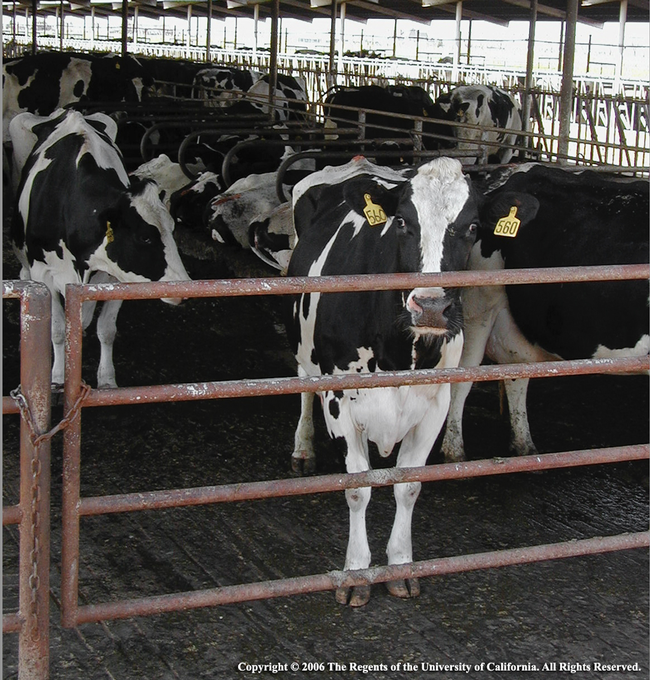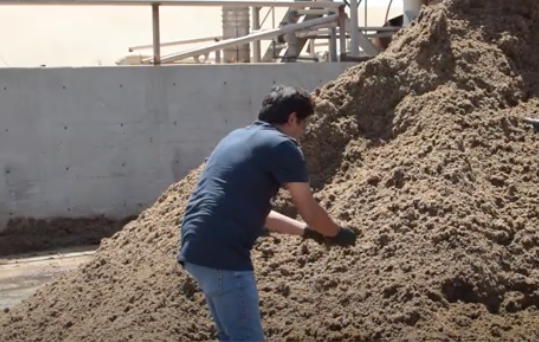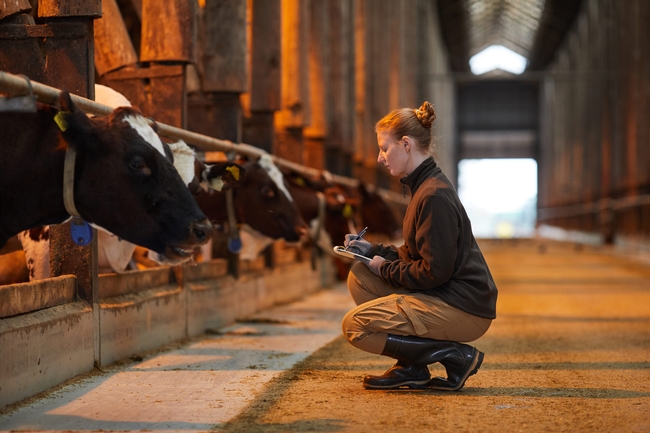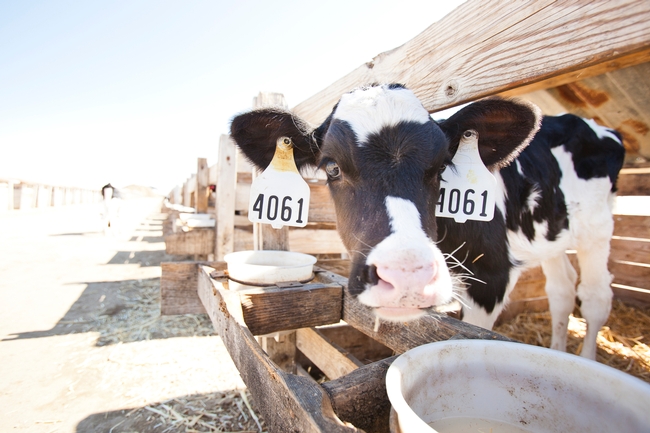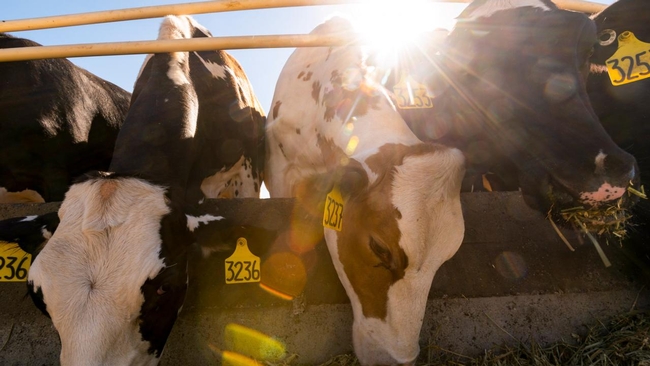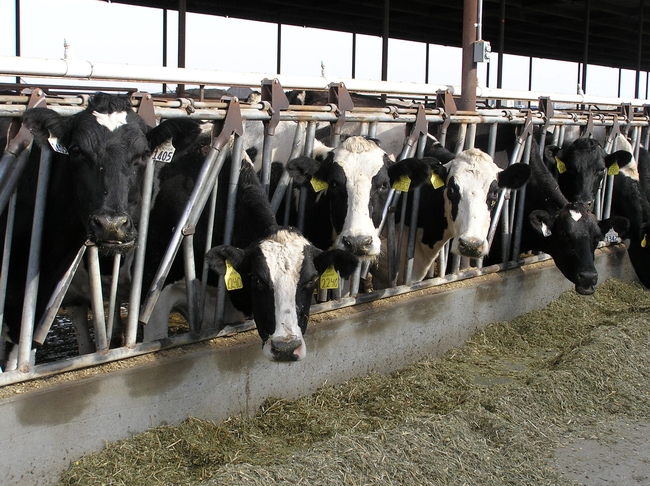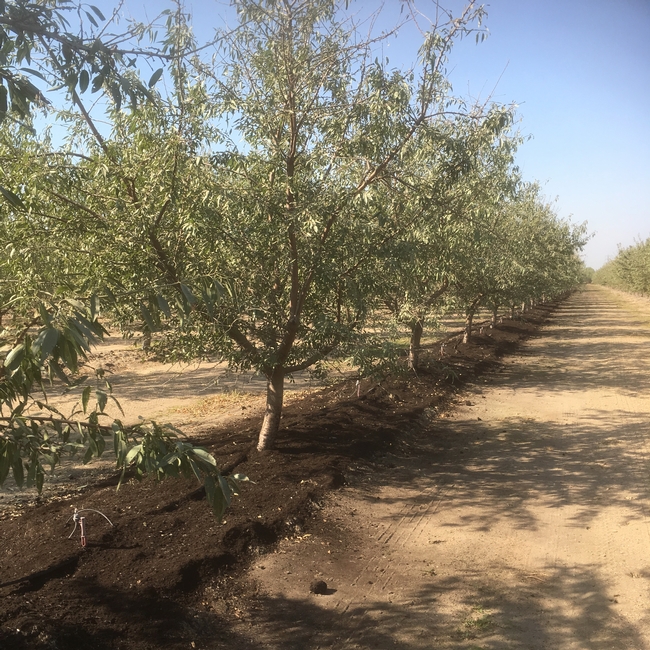Posts Tagged: dairy
California dairy farmers generate renewable energy from waste
California ranks number one in the nation for dairy production, with 1,100 to 1,200 dairy farms, each with an average of 1,436 cows, mostly concentrated in Tulare County in the San Joaquin Valley. A major dairy waste is cow manure, a byproduct that can require millions of dollars for each dairy to manage.
To help manage the manure, the California Department of Food and Agriculture provides funds to California dairy farms to install dairy digesters, a technology that can break down manure and produce methane (a form of renewable energy). The digesters provide additional benefits such as capturing greenhouse gases while improving the nutrient value of manure and water quality.
Pramod Pandey, UC Cooperative Extension specialist in the School of Veterinary Medicine Extension at UC Davis, has been studying dairy digesters for over 20 years to understand the conversion of manure into renewable energy. He also is trying to determine the effects of anaerobic processes (in low-oxygen conditions) on dairy manure quality, biogas production and the environment.
Between 2015 and 2022, CDFA supported approximately 133 dairy digester projects in California, with grants of more than $200 million to various dairy farms.
“The California state government plays a big role in the success of this technology because the majority of dairy farmers are not financially able to invest in implementing the manure management technology, which assist both dairy farms and community,” said Pandey.
For dietary components that cannot be completely digested by a cow's stomach, dairy digesters use a variety of bacteria to break down the manure under anaerobic conditions. This provides an option for sustainable waste treatment. The process not only reduces greenhouse gas emissions by capturing the gases released from manure, but also produces renewable energy in the form of biogas, which can be used as an alternative fuel for cars to further bring down greenhouse gas emissions. In addition, the dairy digester helps reduce odor and pathogens that pose a risk to human health.
According to Pandey, one cow can theoretically produce roughly 100 pounds of wet manure daily, and this manure contains nitrogen and phosphorous, which are important for soil. About 40 cubic feet of biogas is produced from the manure of one cow under anaerobic conditions, and this biogas has a potential to produce around 24,000 btu per cow. In California, a 1,000-square foot home uses 45,000 to 55.000 btu per day for heating and cooling. That means manure from two or three cows could meet the daily energy demand of a small home.
By using digesters, farmers can prevent greenhouse gas emissions and simultaneously generate energy and soil amendments, which provide nutrients to cropland, lessening the amount of commercial fertilizer needed. By connecting technologies, the liquid from digesters can be improved to produce water that can be used for irrigation and for meeting the water demands of a dairy farm.
“The main purpose of a dairy farm is to produce milk, and current low milk prices make it difficult for dairy farmers to focus on manure management without the support from government,” Pandey said, adding that managing waste is not only expensive but time-consuming. Although dairy digesters can cost $5 million to $10 million to build and install, the technology is helpful in manure management.
Dairy farmers traditionally use anaerobic or manure lagoons to store their liquid manure waste until they are ready to apply it to farmland as fertilizer. The issue is that the lagoons emit greenhouse gases such as methane into the atmosphere.
“It is important to not overexpect from a dairy digester because it doesn't reduce all forms of pollution from manure completely,” Pandey said. “But given the available resources, funding and technology, I would say that we're off to a good start.”
Dennis Da Silva, a dairy farmer in Escalon, has been working in the industry his entire life and used to be “totally against” digesters. In the late 1970s, Da Silva's father, who immigrated from Portugal, started Da Silva Dairy Farm, which Da Silva currently runs.
“I spend a lot of money getting solids out of my lagoons every year,” Da Silva said.
Although he does not have digesters set up on his farm just yet, Da Silva agreed with Pandey that the government has made it much easier for farmers like himself to tackle waste.
“I used to be against the dairy digester idea, but there's a lot more incentive to invest these days,” said Da Silva. “It's also likely that, in the future, there'll be regulations that will crack down on dairy farms if you don't already have digesters,” he added.
Currently, he is in the permitting phase, waiting for approval to begin building the digester on his farm, which is expected to take about two years.
Pandey said that the process is slow and there is still a lot of room for improvement, but the intention is a step in the right direction. “The only thing that the digester doesn't produce is milk,” Pandey said jokingly.
RELATED LINK
VetMed Extension Spotlight on Pramod Pandey https://youtu.be/qKcGMcT8-UI.
Dairy Industry Innovation Assessment Tool identifies most promising solutions
The Hague, NL – The dairy industry in both California and the Netherlands faces four major challenges: manure management, enteric methane, labor, and sustainability measurements and standards. To identify existing and emerging market solutions and assess the impact of these solutions across the four categories and animal welfare, an innovation assessment tool has been created.
The VINE, an initiative of the University of California Agriculture and Natural Resources, and Wageningen Livestock Research - Dairy Campus have released their novel Global Dairy Industry Innovation Assessment Tool. This tool is the first step in a joint dairy collaborative aimed at promoting sustainable, climate-smart agriculture for a better future.
"The partnership between The VINE and Wageningen Livestock Research - Dairy Campus has enabled us to combine our expertise and insights to create an overview of these key challenges and opportunities for the dairy industry,” said Gabe Youtsey, chief innovation officer for UC ANR. “Understanding this landscape of innovation allows us to leverage our shared resources to support and drive the commercialization of solutions.”
“Innovation is key for the future development of the dairy sector in both countries” said Kees de Koning, manager Innovation at Dairy Campus.
This tool provides a snapshot of the current state of innovation addressing some of the challenges in the dairy industry, showcasing innovative technologies and products that are, or have the potential to, make a difference on a global scale. By identifying the most promising solutions and encouraging collaboration among key industry players, the team aims to drive further progress toward a sustainable dairy industry.
The database lists companies, identifies which challenges their product addresses and ranks the maturity of the product from “proof of concept” to “mature.”
“This Global Dairy Industry Innovation Assessment Tool is designed to give insights on the opportunities and tradeoffs inherent in deploying any new technology,” said Mareese Keane, co-founder of Opengate and partner of The VINE. “It is a living database and any companies that want to add or update their entry are invited to get in touch."
To complement the assessment tool, The Vine and Wageningen dairy collaboration are working on the following projects:
- Building Blocks for Virtual Future Farm: Envisioning a theoretical farm with zero emissions or maximum circularity by leveraging Dutch precision technology and California large-scale farming expertise.
- The VINE VIP (Validation of Innovations Project): Focusing first on value-added products from manure, participants will look for technologies that provide value-added products at scale from manure, beyond energy and direct application as fertilizer.
- A delegation of California-based dairy industry innovators and operators are invited to join an innovation tour of the Dutch dairy industry, starting Nov. 6.
Click here to view the Dairy Innovation Assessment Tool: https://airtable.com/shrMIHqbWNnwhJs8y/tblN8IzvBQ5kAwSou
For more information about the Dairy Innovation Assessment Tool, how the companies included were selected, and how to submit or update additional entries, please visit https://thevine.io/towards-better-dairy-global-innovation-landscape.
About The VINE: The VINE, an initiative of the University of California, Agriculture and Natural Resources, is California's agriculture, food and biotech innovation network. The VINE aims to harness the power of open innovation to help industries and entrepreneurs grow and scale globally while catalyzing technology innovation and commercialization for productive, sustainable, and equitable food systems.
About Wageningen Livestock Research - Dairy Campus: Wageningen Dairy Campus is a leading research institution in the Netherlands focused on dairy farming and sustainability. The Dairy Campus provides a platform for education, research and innovation, bringing together industry partners, academi, and government organizations to advance sustainable practices in the dairy sector.
Report: California on path to significant dairy methane reduction
Researchers say dairy farms on track to achieve full 40% reduction goal by 2030
The California Dairy Research Foundation and University of California, Davis CLEAR Center announced on Dec. 14 the release of a new analysis of methane reduction progress titled "Meeting the Call: How California is Pioneering a Pathway to Significant Dairy Sector Methane Reduction." The paper, authored by researchers at UC Davis affiliated with UC Agriculture and Natural Resources, concludes that efforts are on track to achieve the state's world-leading target for reducing dairy methane emissions by 40% by 2030.
The report, written by distinguished professors of livestock emissions and agricultural economics, takes a comprehensive look at progress and projections, expanding upon the analysis of progress previously conducted by the California Air Resources Board. By documenting achievements to date, additional reduction efforts already funded, historic and current economic trends, and the projected availability of new solutions, the analysis lays out a workable path toward meeting California's goal. The pathway shows that California dairy farms are on track to achieve the full 40% dairy methane reduction goal and will reach “climate neutrality” by 2030. Climate neutrality is the point in which no additional warming is added to the atmosphere.
“This analysis shows that California's dairy sector is well on its way to achieving the target that was established by SB 1383 in 2016,” said CDRF's Executive Director Denise Mullinax. “With much important work still ahead, a clear understanding of this pathway helps dairy farmers, policy makers, researchers, and other partners make decisions to strategically press forward.”
The report outlines the need for continued implementation of California's four-part strategy for dairy methane reduction: farm efficiency and herd attrition, methane avoidance (alternative manure management), methane capture and utilization (digesters), and enteric methane reduction. Continued alignment of state and federal climate-smart agricultural approaches and incentives will also be critical to maintaining progress.
"Milk demand is growing, and California is among the world's low-cost suppliers of dairy products. It follows that effective California policy to reduce dairy greenhouse gas emissions must recognize that measures that cause milk production to exit the state do not mitigate global climate change," said study co-author Daniel Sumner, Distinguished Professor in the Department of Agriculture and Resource Economics at UC Davis. "Therefore, measures to help off-set mitigation costs, provide positive incentives for adoption of low-cost emission-reducing practices, and help stimulate innovation in methane reduction, are the economically efficient approaches."
The paper recognizes that enteric methane from the dairy and other livestock sectors is a significant source of greenhouse gas emissions in the U.S. and California. Several feed additives are expected to become commercially available in the next several years, which could be used to reduce enteric methane emissions from California's dairy herd.
“Adoption of enteric feed additives will become a valuable tool for dairy value chains to meet their greenhouse gas reduction goals,” said co-author and professor Ermias Kebreab, associate dean of global engagement and director of the World Food Center at UC Davis. “While this report provides only a broad overview of some of the most promising solutions, there is an incredible amount of research being conducted at UC Davis, nationally and internationally. The dairy industry, global food companies, state and federal agencies, and others continue to invest heavily in supporting enteric mitigation research efforts.”
The report finds that methane reductions from California's programs and projects in place today, coupled with the implementation of a moderate feed additive strategy to reduce enteric emissions, is on track to reduce between 7.61 to 10.59 million metric tons of methane (CO2e) by 2030, all from the dairy sector alone.
The collective investment in California's dairy methane reduction effort — from public and private funding — now exceeds $2 billion and counting. The California dairy sector, in coordination with the California Department of Food and Agriculture, was recently awarded up to $85 million by the United States Department of Agriculture under the Partnerships for Climate-Smart Commodities. The funding will leverage additional matching state funds and private capital investments, for a total of more than $300 million in new investment.
“It is important to highlight California's investments and success to date as an example of what is possible within the global livestock sector,” said co-author Frank Mitloehner, UC Davis animal science professor and air quality specialist in Cooperative Extension, and director of the UC Davis CLEAR Center. “California dairy farmers have demonstrated tremendous progress toward the state's methane reduction goal over the past several years. Given the short-lived nature of methane, this rapid reduction is an important contribution to the global effort to quickly limit climate warming.”
The author's analysis was prepared by Gladstein Neandross & Associates (GNA). Funding was provided by CDRF as part of its work to support an innovative and sustainable California dairy industry.
UC ANR offers seminars, citrus tour at World Ag Expo
UC Dairy Series
A series of dairy seminars will be offered by UC Agriculture and Natural Resources scientists at the World Ag Expo. Presentations will cover the latest research on almond hulls as dairy feed, water management, nutrient management, manure management and much more. See the schedule below.
Tuesday, Feb. 8, 2022
Seminar Trailer 2
Session 1: Nutrient Management & Manure Treatment Technologies
Tuesday, 1:00 – 1:55 p.m.
1 p.m. – Joy Hollingsworth, UC Cooperative Extension nutrient management and soil quality advisor for Tulare, Kings, Fresno and Madera counties
Nutrient management with digester effluent
1:15 p.m. – Anthony Fulford, Ph.D., UC Cooperative Extension nutrient management and soil quality advisor for Stanislaus, Merced and San Joaquin counties
Incorporating vacuumed manure into your nutrient management needs
1:30 p.m. – Nick Clark, UC Cooperative Extension agronomic cropping systems and nutrient management advisor for Kings, Fresno and Tulare counties
Nutrient management with other advanced treatment technologies
1:45–1:55 p.m. – Q&A session
Session 2: Manure management options on your dairy
2–2:55 p.m.
2 p.m. – Betsy Karle, UC Cooperative Extension dairy advisor for Glenn, Butte, Tehama,
Shasta, Sutter and Yuba counties
CDFA's Alternative Manure Management Program - where to start
2:15 p.m. – Frank Mitloehner, Ph.D., UC Cooperative Extension specialist in livestock systems and air quality, UC Davis Department of Animal Science
Manure technologies & pre/post greenhouse gas emissions
2:30 p.m. – Ruihong Zhang, Ph.D., UC Davis professor in the Department of Biological & Agricultural Engineering
Novel technologies for manure management on dairies
2:45–2:55 p.m. – Q&A session
Wednesday, Feb. 9, 2022
Seminar Trailer 2
Session 3: Feeding the California Dairy Herd
1–1:55 p.m.
1 p.m. – Jennifer Heguy, UC Cooperative Extension dairy advisor for Stanislaus, Merced and San Joaquin counties
Almond hull usage on California dairies
1:15 p.m. – Ed DePeters, Ph.D., UC Davis professor in the Department of Animal Science
Almond hulls - the story continues
1:30 p.m. – Dan Putnam, Ph.D., UC Cooperative Extension specialist in the UC Davis Department of Plant Sciences
Low lignin alfalfa considerations for yield & feed quality
1:45–1:55 p.m. – Q&A session
Session 4: Water-wise dairying
2–2:55 p.m.
2 p.m. – Nick Clark, UC Cooperative Extension agronomic cropping systems and nutrient management advisor for Kings, Fresno and Tulare counties
Sugar beet and safflower – yield, water use and nutrient management considerations
2:15 p.m. – Mark Lundy, Ph.D., UC Cooperative Extension specialist in the UC Davis Department of Plant Sciences
Maximizing water productivity from winter small grains in California
2:30 p.m. – Khaled Bali, Ph.D., UC Cooperative Extension irrigation water management specialist at Kearney Agricultural Research and Extension Center
Deficit irrigation and winter groundwater recharge in alfalfa
2:45–2:55 p.m. – Q&A session
Need continuing education unit credits?
American Registry of Professional Animal Scientists (ARPAS): 1 CEU/session; 4 total available
Certified Crop Adviser: 2 CEU available
Nutrient Management: 1 CEU (Sessions 1 & 2)
Soil & Water Management: 1 CEU (Session 4)
California Department of Food and Agriculture's Irrigation and Nitrogen Management Program: 2 CEU available
Nitrogen Management: 1 CEU (Sessions 1 & 2)
Irrigation Management: 1 CEU (Session 4)
Feb. 10 citrus tour (9:30 a.m.–3:30 p.m.)
The citrus tour will visit two locations: University of California Lindcove Research & Extension Center and McKellar Family Farms.
Established in 1959, the UC Lindcove REC has more than 100 acres of citrus in the heart of the San Joaquin Valley. At the center, researchers conduct studies on citrus varieties, horticultural techniques and pest management. The UC Lindcove REC portion of the tour will include a display and tasting of citrus varieties.
Lunch is provided at McKellar Family Farms, where visitors will tour the citrus orchards, view equipment and get a better understanding of the process from tree to table. By the end of the tour, visitors will have an understanding of how much care and forethought goes into producing top-quality fruit, in addition to the research conducted to improve growing conditions.
Tour tickets cost $45 and include choice of lunch. For more information, visit https://www.worldagexpo.com/attendees/agriculture-tours.
Dairy’s Net Zero Initiative gets boost with $10 million research grant
The Foundation for Food & Agriculture Research has awarded a $10 million grant to support U.S. dairy's Net Zero Initiative as a critical on-farm pathway to advance the industrywide 2050 Environmental Stewardship Goals set through the Innovation Center for U.S. Dairy.
In California, UC Davis and UC Agriculture and Natural Resources scientists will collaborate on the nationwide project addressing carbon sequestration, soil health and nitrogen management.
"The Foundation for Food and Agricultural Research grant in partnership with Soil Health Institute and Dairy Research Institute are funding research that will positively impact the future of animal and plant agriculture in a world with increasingly limited natural resources,” said Deanne Meyer, UC Cooperative Extension specialist based at UC Davis, who studies livestock waste management.
Working with California dairy forage and almond producers, UC Cooperative Extension scientists and technicians will evaluate and demonstrate the impacts of using manure products as fertilizer in combination with more traditional soil conservation practices.
“With this research, there's a potential to expand the use of dairy manure products beyond forage crops to crops such as almonds,” said Nick Clark, UC Cooperative Extension farm advisor for Fresno and Tulare counties. “We expect results to demonstrate that groundwater quality and quantity can be protected and preserved, and crop yields can be maintained without increasing net greenhouse gas emissions from crop production.”
Clark added, “We look forward to working with our local producers and connecting with our national partners and collaborators to examine and demonstrate the best practical solutions that science has to offer for farming in tomorrow's world."
California dairy operators who would like to participate in the experiment may contact Clark for more information at neclark@ucanr.edu.
Data from the “Dairy Soil & Water Regeneration: Building soil health to reduce greenhouse gases, improve water quality and enable new economic benefits” project will be broadly shared among the dairy community. The six-year project will provide measurement-based assessments of dairy's greenhouse gas footprint for feed production. It will also set the stage for new market opportunities related to carbon, water quality and soil health.
“Addressing the U.S. dairy industry's emissions is a critical solution to climate change,” said FFAR Executive Director Sally Rockey. “I know dairy farmers are working hard to decrease their environmental footprint and I'm thrilled to support their efforts by advancing research needed to adopt climate-smart practices on dairy farms across the country.”
Through foundational science, on-farm pilots and development of new product markets, the Net Zero Initiative aims to knock down barriers and create incentives for farmers that will lead to economic viability and positive environmental impact.
“After six years, we will have data that accurately reflect our farms' greenhouse gas footprint for dairy crop rotations with consideration for soil health management practices and new manure-based products,” said Jim Wallace, Dairy Management Inc. senior vice president of environmental research. “We expect to develop critical insights that link soil health outcomes, such as carbon sequestration, with practice and technology adoption. This will provide important background information to support the development of new carbon and water quality markets.”
The project will be executed across four dairy regions responsible for about 80% of U.S. milk production: Northeast, Lakes, Mountain and Pacific. In addition to UC Agriculture and Natural Resources and UC Davis, collaborators include the Soil Health Institute and leading dairy research institutions, including Cornell University, Texas A&M AgriLife Research, University of Wisconsin-Madison, University of Wisconsin-Platteville, University of Vermont, and U.S. Department of Agriculture's Agricultural Research Service (USDA ARS) Northwest Irrigation and Soils Research in Idaho.
Dozens of dairies representing climates and soils of these major production regions will participate in a baseline survey of soil health and carbon storage. Additionally, eight farms, including five operating dairies, two university research dairies and one USDA ARS research farm, will participate in the project. These pilots will be used to engage farmers in soil health management practices and monitor changes in greenhouse gas emissions, soil carbon storage, soil health and water quality.
The FFAR grant will be matched by financial contributions from Net Zero Initiative partners such as Nestlé, the dairy industry, including Newtrient, and in-kind support for a total of $23.2 million. The funds will be managed by the Dairy Research Institute, a 501(c)(3) non-profit entity founded and staffed by Dairy Management Inc., whose scientists will serve as the project leads to address research gaps in feed production and manure-based fertilizers.
About the partners
FFAR builds public-private partnerships to support bold science that fills critical research gaps. Working with partners across the private and public sectors, FFAR identifies urgent challenges facing the food and agriculture industry and funds research to develop solutions.
NZI is an industrywide effort led by six national dairy organizations: Dairy Management Inc., Innovation Center for U.S. Dairy, International Dairy Foods Association, Newtrient, National Milk Producers Federation and the U.S. Dairy Export Council. This collaboration represents a critical pathway on U.S. dairy's sustainability journey.
For more information about dairy sustainability, visit www.usdairy.com/sustainability.

